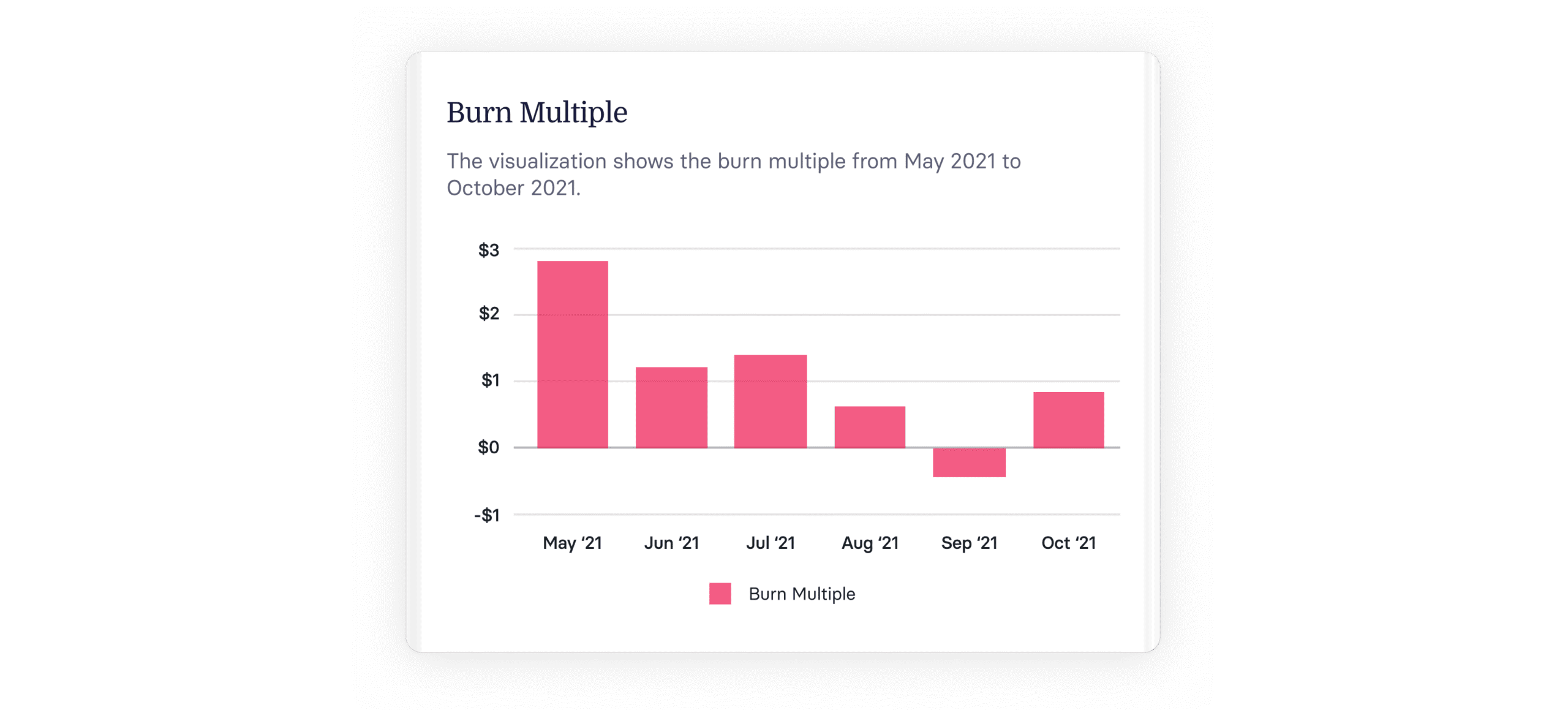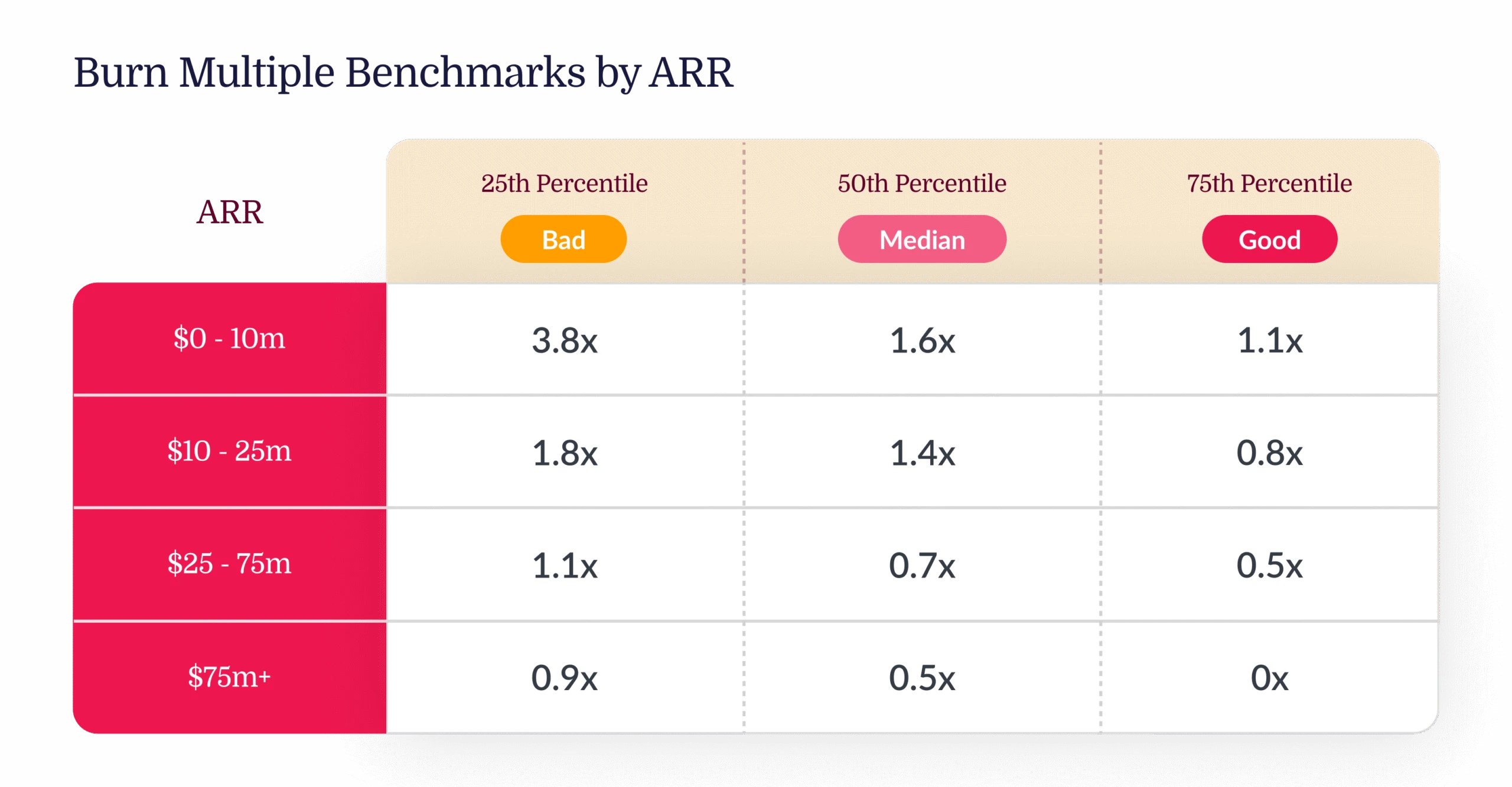Burn multiple is a critical metric for assessing capital efficiency, showing the revenue generated per dollar spent.
What is burn multiple?
Burn multiple is a broad capital efficiency metric that shows how much revenue your company generates for every dollar it burns. Unlike net burn rate alone, burn multiple reflects how efficiently you’re using raised capital across the entire business to produce revenue.
<<Download the SaaS metrics cheat sheet.>>

Unlike sales- and marketing-focused ratios such as LTV/CAC, burn multiple captures the impact of decisions across all functions. Understanding it can help you identify opportunities to extend runway through smarter cash management—something especially critical in challenging market conditions.
For a time, “growth at all costs” was a common mindset for VC-backed companies. Funding was readily available, and efficiency mattered less than top-line expansion. But as markets shift, sustainable growth requires a balance between efficiency and scale. Foundational principles like the Rule of 40 underscore this balance by combining growth rate and profitability into one measure of health.
Plenty of SaaS metrics can help monitor this balance—ARR, CAC, LTV, and retention among them. But one has become particularly important to both investors and operators in recent years: burn multiple. Here’s what you need to know about this key efficiency metric.
Burn multiple formula and how to calculate it
You can calculate your burn multiple by dividing your net burn by net new annual recurring revenue (ARR) for a given period:

The formula was introduced by David Sacks of Craft Ventures as a way to measure efficiency during market downturns. It builds on earlier metrics like Bessemer’s efficiency score and the hype ratio, both of which compare burn, capital, and ARR to evaluate performance.


By flipping the inputs of Bessemer’s formula, the burn multiple essentially becomes an annualized hype ratio. The result is a simple way to understand how much money your company burns to generate each new dollar of ARR.
Because the calculation can be run monthly, quarterly, or annually, it gives both a micro and macro view of capital efficiency—making it especially valuable when efficiency and runway are under scrutiny.
Key takeaways
- Burn multiple is a critical metric for assessing capital efficiency, showing the revenue generated per dollar spent
- Calculating burn multiple involves dividing net burn by net new annual recurring revenue (ARR) over a specific period
- A lower burn multiple indicates more efficient growth, while a higher value suggests greater capital expenditure for revenue generation
- Companies can improve burn multiple by lowering customer acquisition costs (CAC), enhancing margins, and optimizing expense management
- Regular revenue forecasting and scenario planning can help maintain an agile approach, improving financial decision-making and operational efficiency
How to understand your burn multiple
The more a company spends to achieve a unit of growth, the higher its burn multiple. More efficient growth results in a lower burn multiple—closer to zero.
What’s considered a “good” burn multiple depends on your stage of growth:
- Seed stage: It’s common to see a higher burn multiple early on. Companies are investing heavily to build the product and acquire initial customers, often before customer acquisition costs (CAC) are fully paid back.
- Mid-to-late stage (Series B and beyond): At this point, investors expect to see efficiency improving. Scaling operations should bring down the burn multiple as revenue growth begins to outpace net burn.
The key is to always interpret burn multiple in context. Use benchmarks—such as those published by firms like a16z—to compare your company’s performance against peers at a similar stage. This helps you understand whether your efficiency is on track, or if there’s room for improvement.

Recommended For Further Reading
How to improve your burn multiple
If your burn multiple isn’t where you’d like it to be, there are several ways to improve efficiency and manage cash more effectively.
Lower CAC
Reducing customer acquisition cost (CAC) shortens the CAC payback period, meaning customers begin contributing to profit sooner. Improving CAC requires close collaboration between sales and marketing. Together, teams can examine where CAC is too high or where sales productivity slows down.
- Are sales reps taking too long to ramp?
- Can the sales cycle be shortened?
- Should marketing rebalance spend between paid ads and SEO to improve cost efficiency?
These are all levers that can help lower CAC and improve overall burn multiple.
Improve margins
Gross margin is a key indicator of operational efficiency. If costs of revenue (COGS) or spending on headcount and product development are too high, burn will rise quickly. Look for areas where you can trim costs without sacrificing growth.
For example, make sure you’re categorizing costs correctly: customer service time spent on support belongs in COGS, but if the same team also supports sales and marketing, those hours should be reflected there. Accurate categorization ensures you’re measuring efficiency correctly, especially when calculating fully burdened CAC.
It’s also worth evaluating software spend. If licenses are charged per seat, department leaders should check whether unused seats are driving unnecessary costs.
Manage churn and downgrades
ARR is highly sensitive to customer churn and contract downgrades. Retaining customers—even at a lower price point—is usually better than losing them altogether, since it guarantees some recurring revenue.
That said, be mindful of discounts or promotions. While they may help secure renewals, they also increase marketing spend and can impact burn if not managed carefully.
Make revenue forecasting and scenario planning more agile
Finance holds the levers that can shift a business from reactive to proactive. If you normally forecast revenue annually, consider moving to a quarterly cadence—especially during uncertain market conditions. This allows you to build more accurate top-line models and adjust assumptions as circumstances change.
More frequent scenario planning takes this a step further. It helps you understand how different strategies could affect revenue growth and burn. For example:
- Collaborate with sales and marketing to model scenarios that drive bookings and improve ARR
- Run customer cohort analyses to spot seasonality trends and track how new customers impact growth
- Examine ACV and CAC shifts to see whether contract values are changing and whether acquisition costs are rising or falling
- Model cash inflows and outflows to understand the impact of billing cycles and vendor payments on ARR
By testing multiple scenarios, you’ll see where opportunities exist, where risks may arise, and how to keep your business financially agile.
<<Download HiBob’s SaaS metric cheat sheet for everything you need to know about 20+ SaaS metrics.>>
Burn multiple FAQs
What is a good burn multiple?
What’s considered “good” depends on your stage of growth. For early-stage startups, investors often look for a burn multiple close to 1, with the goal of moving closer to 0 as the company matures and valuations increase. Lower multiples signal more efficient growth.
How do you reduce burn multiple?
Because burn multiple reflects the efficiency of the entire business, improvements can come from many areas. The goal is to reduce operating expenses while continuing to drive growth. For example, you might:
- Reevaluate marketing campaigns—cut spend on what isn’t working and double down on strategies that generate pipeline
- Reduce discretionary spend, like travel or events, if they’re significant cost drivers
- Delay large projects, such as office expansions or company-wide offsites, to conserve cash
- As a last resort, consider adjusting headcount if personnel costs are disproportionately high
Is there a difference between burn rate and burn multiple?
Yes. Burn rate measures how much cash a company spends during a set period, usually monthly. Burn multiple goes further by comparing net burn to net new ARR. This makes it a more comprehensive measure of efficiency, showing how much revenue growth you generate for each dollar burned.

